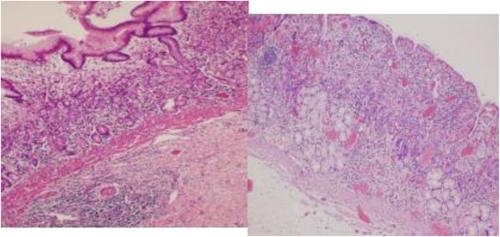Value of quantitative microsurface structure analysis for evaluating the invasion depth of type 0–II early gastric cancer
Abstract
Background and Aim
The microsurface structure reflects the degree of damage to the glands, which is related to the invasion depth of early gastric cancer. To evaluate the diagnostic value of quantitative microsurface structure analysis for estimating the invasion depth of early gastric cancer.
Methods
White-light imaging and narrow-band imaging (NBI) endoscopy were used to visualize the lesions of the included patients. The area ratio and depth-predicting score (DPS) of each patient were calculated; meanwhile, each lesion was examined by endoscopic ultrasonography (EUS).
Results
Ninety-three patients were included between 2016 and 2019. Microsurface structure is related to the histological differentiation and progression of early gastric cancer. The receiver operating characteristic curve showed that when an area ratio of 80.3% was used as a cut-off value for distinguishing mucosal (M) and submucosal (SM) type 0–II gastric cancers, the sensitivity, specificity, and accuracy were 82.9%, 80.2%, and 91.6%, respectively. The accuracies for distinguishing M/SM differentiated and undifferentiated early gastric cancers were 87.4% and 84.8%, respectively. The accuracy of EUS for distinguishing M/SM early gastric cancer was 74.9%. DPS can only distinguish M-SM1 (SM infiltration <500 μm)/SM (SM infiltration ≥500 μm) with an accuracy of 83.8%. The accuracy of using area ratio for distinguishing 0–II early gastric cancers was better than those of using DPS and EUS (P < 0.05).
Conclusion
Quantitative analysis of microsurface structure can be performed to assess M/SM type 0–II gastric cancer and is expected to be effective for judging the invasion depth of gastric cancer.


 求助内容:
求助内容: 应助结果提醒方式:
应助结果提醒方式:


